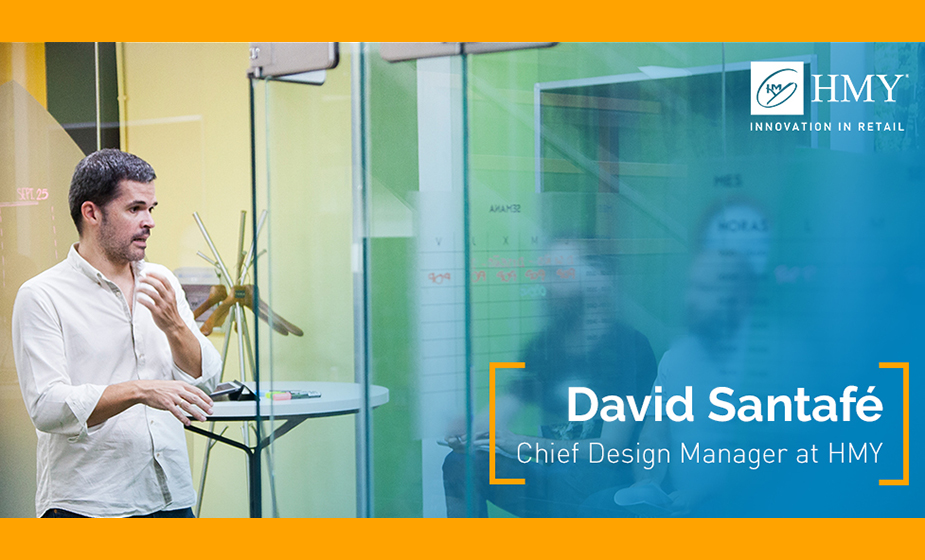David Santafé, Chief Design Manager at HMY: “Innovation in retail should always be productive for both the brand and the consumer”
The retail world is constantly changing. This is causing brands to look for their own place within the sector as a way to position themselves as the best possible option for consumers and to look for new solutions in pursuit of this goal in a saturated market.
In order to learn more about the current state of the retail sector, and the possibilities for brands to stand out in a sector with so many players, we spoke with David Santafé Fondevila, Chief Design Manager at HMY.

Differentiation in Price and Assortment No Longer Exists
The entry of business digitalization in the sector has changed the rules of the game. What was valid before has now changed substantially, making the previous model of the product that was differentiated obsolete. In the words of David Santafé:
“For brands nowadays, the challenge does not lie in the price or assortment of products that they offer. Brands are concerned about competing for visibility, since, after the arrival of online shopping to the retail sector, competition on those two levels has become very complex. Differentiation lies in offering something more to the customer at the physical point of sale and at all points of contact with the customer.”
This paradigm shift is obvious and all brands have to work hard to achieve the objectives that they set out to attain. It’s time for customers to start to live the brands.
Living the Brand Is Part of the Solution
It is possible that, as a retailer, you are wondering what living the brand means to your audience. This means the customer’s presence in physical retail spaces should be beneficial to clients. As our Chief Design Manager, David Santafé, says:
“Offering the customer new, distinctive experiences within the point of sale is one of the ways to get them to live the brand. Technology, as a way of achieving this goal, plays a very important role. Not only that, but these experiences must go hand in hand with the brand’s DNA and the positioning it has or intends to have within the market.”
But of course, everyone can offer technological experiences that are interesting, attractive or able to entertain anyone. However, as David Santafé says, there is a concept that cannot be left out when it comes to the creation of an experience:
“We live surrounded by technology. This means that its use at the point of sale is no longer remarkable nor does it attract the attention of consumers. So, innovation does not lie in technology itself or in its development, but in the application of this technology to new needs never forgetting that their goal, in addition to attracting the attention of consumers, should be to generate a profit from this.”
Therefore, as you can see, the goal is not to impress your customers with complex technologies that really do not have a defined objective, but in the application of them. In the search for this benefit, it is possible to find the true value that we, as a retail brand, can contribute to our customers. David Santafé assures that:
“Innovating and surprising the customer are a must. Yes, but always going beyond that, experience by experience. Limits must be established about which technologies are just surprising, and which ones are productive. Why? Because our goal as retailer is to associate our brand with that positive experience that only we can offer. To be unique. This is the only way we can ensure that we will get a positive return on our investment in our business.”
But how do we get this benefit?

In conclusion, as we see, there are several strategies that can be applied by any retail company who wants to stand out in a market that is so saturated with options. To create these experiences, David Santafé, our Chief Design Manager, recommends taking the following points into account:
Innovating and surprising beyond experience by experience. A positive return on investment only happens if that experience is related to a benefit for the buyer.
The brand must be clearly positioned within its own sector. In the past, all brands tended to seek a very global audience, meaning successful brands were the ones that were addressing the public. Today, brands must position themselves very clearly and address their target consumer.
Technology must have a clear, defined use. The use of technology on its own is no longer differential. Finding new uses and applying them to innovation in order to ensure a benefit to the customer is key.
Improving on the product with a positive experience and service will be a benefit that works in two directions: on one hand it works for the customer as the experience that they have with our brand, and on the other hand it works for the brand itself, since all of these technologies act as facilitators in the purchasing decision.